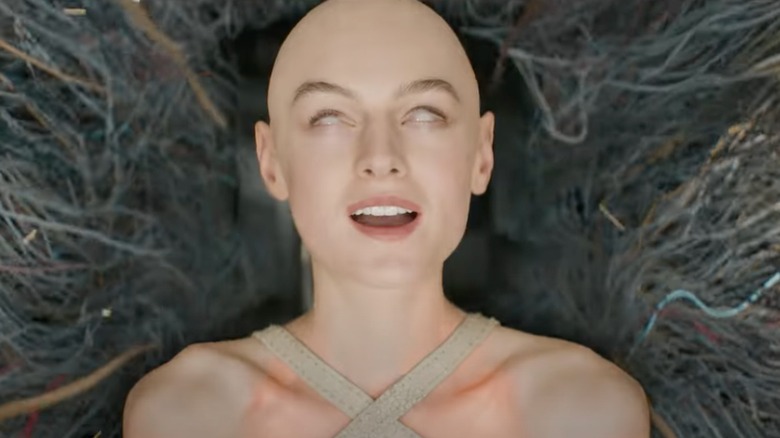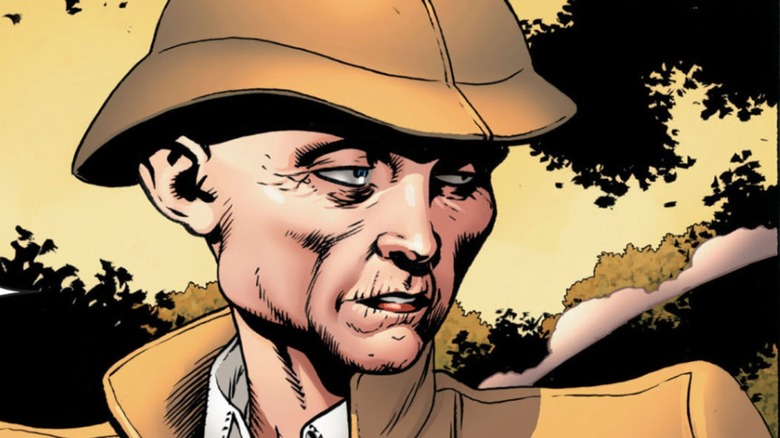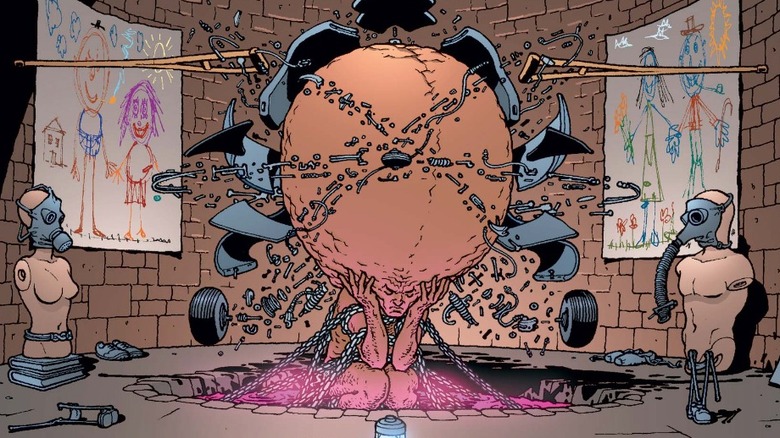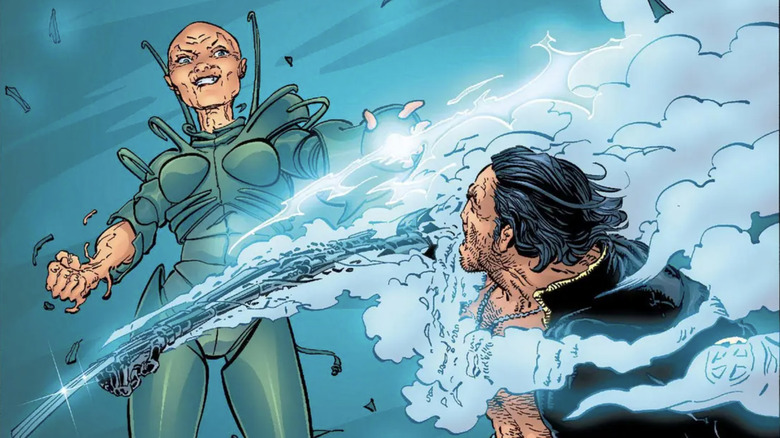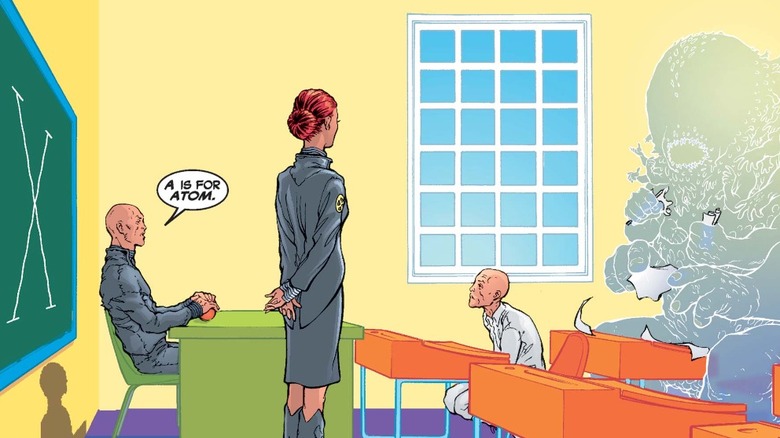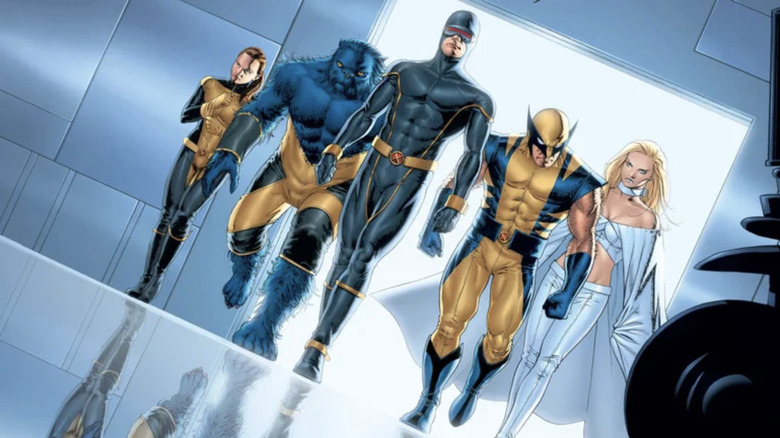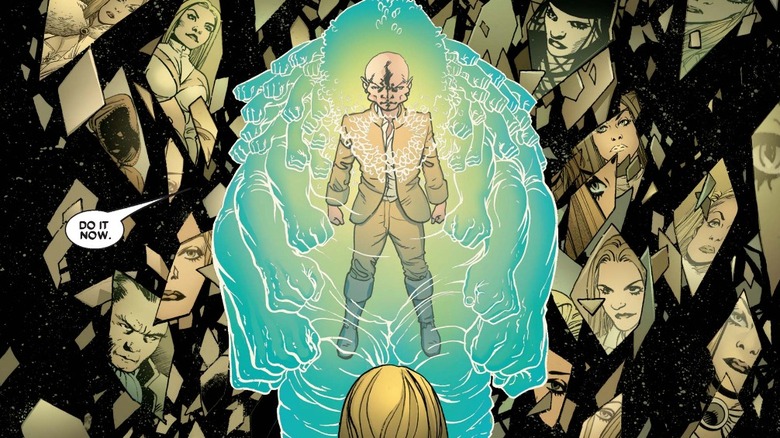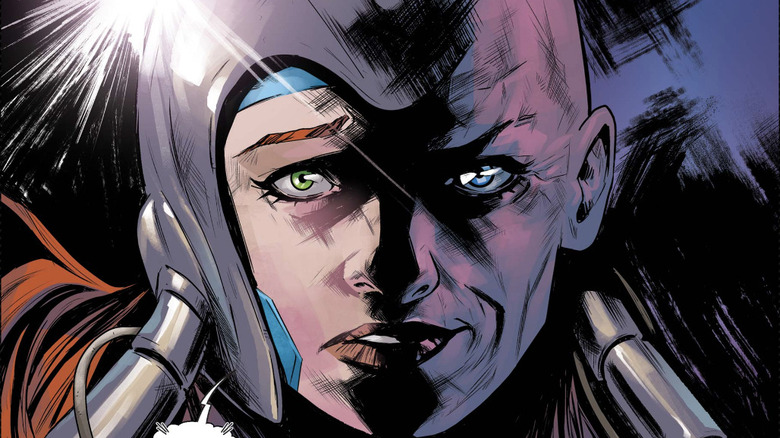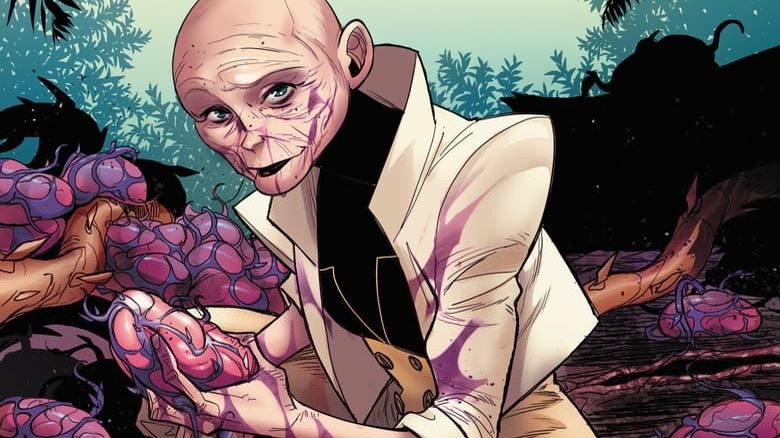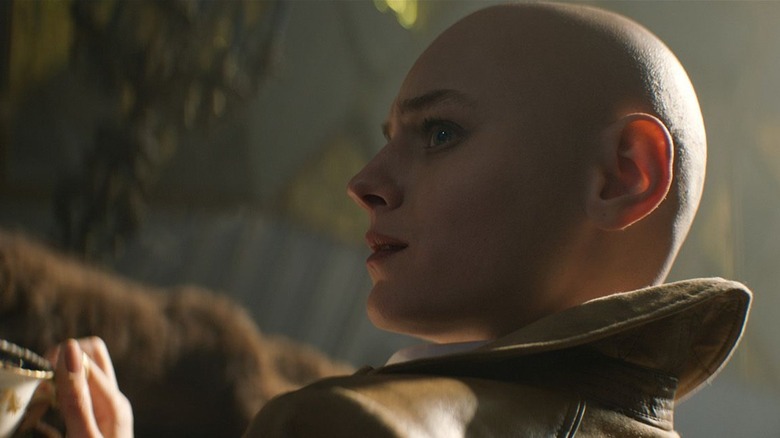The Totally Bonkers Comic Book History Of Cassandra Nova, Deadpool & Wolverine's Villain
What kind of villain could force Deadpool and Wolverine to team up? Well, in the upcoming 2024 flick at least, it'll be Cassandra Nova (played by Emma Corrin). The evil twin sister of Charles Xavier (sort of), Cassandra is her brother's polar opposite: a genocidal evildoer who delights in snuffing out mutant lives and the dreams they carry. Her mutant powers also eclipse her brother's; she's not just a telepath, but a telekinetic with regenerative abilities.
Cassandra was introduced in "New X-Men" by Grant Morrison and Frank Quitely. She was the villain of the first two arcs (12 issues) of the series, "E is for Extinction" and "Imperial." Few super-villains have made a more terrifying first impression.
If you watched this year's animated "X-Men '97," then your jaw probably dropped in episode 5, "Remember It," when mutant nation Genosha gets razed to the ground by Sentinels, just as it was in "E is for Extinction." In the show, this genocide turned out to be the work of Mister Sinister and the human-Sentinel hybrid Bastion. Not so in the source material, where Cassandra controlled the Sentinels. Yes, her first act as a villain was killing 16 million mutants.
"Deadpool & Wolverine" looks to be building on past Marvel Cinematic Universe stories like "Loki" and focusing on the multiverse. I would not be surprised if the movie's version of Cassandra (who appears to be leading cast-off mutant villains from 20th Century Fox's "X-Men" films, like Sabretooth, Pyro, and Lady Deathstrike) is made into a simple variant of Charles Xavier. Such a move, however, would do no justice to how singular and unique her comic backstory is.
The beginnings of Cassandra Nova in Marvel's X-Men comics
Cassandra first appears on page 2 of "New X-Men" #114 (Morrison and Quitely's kick-off issue) without prior context. She has whisked away Donald Trask (nephew of Sentinel inventor Bolivar Trask) to an abandoned Sentinel factory in Ecuador. On the ride over, she shows Trask video simulations of the Cro-Magnon savagely wiping out the Neanderthals, and proclaims mutants will do the same to humans in four generations unless they're culled.
So, in issue #115, Trask signs onto her genocide. Revealing she only needed to copy his DNA to control the Sentinels, she kills the now useless-to-her Trask and sends an enormous, self-evolving "Wild Sentinel" off to Genosha. Cyclops and Wolverine (sent to investigate a mutant spike in Ecuador) capture Cassandra, but the X-Men are too caught off guard to stop Genosha. One of the few survivors is the psychic villainess turned mutant teacher Emma Frost, who develops a "secondary mutation" of diamond hard skin. (Emma's students were not so lucky.)
Come issue #116, Cassandra is a prisoner at the X-Mansion. Her presence is inexplicable because Charles does not and has never had a sister. Beast's analyses of her also suggest she is neither human or mutant, despite appearances otherwise. The X-Men don't have much time to ponder because Cassandra breaks free and goes for Cerebra (an upgraded Cerebro), intending to boost her psychic energy and erase every mutant mind on Earth. Before she can, Emma walks up behind Cassandra and snaps her neck. Charles finishes off with a gun, saying "it" didn't deserve to live.
Charles chooses the next day to go on TV and announce himself as a mutant, and then take an interstellar vacation with his alien girlfriend, Empress Lilandra of the Shi'ar. Yeah, something's up...
The continued story of Cassandra Nova in Grant Morrison's X-Men
It turns out that Cassandra pulled a body swap with Charles while briefly in Cerebra; the crippled, dying "Cassandra" is really Professor X, while his twin is working to destroy mutantkind from the inside. When Beast discovers the truth in issue #117, Cassandra puts him in a coma then leaves Earth on a Shi'ar ship with no one the wiser until Beast recovers.
In December 2001, Marvel Comics were published under the banner "'Nuff Said." Each issue was almost or completely dialogue free, forcing writers to rely on visual storytelling. The best issue of this experiment is "New X-Men" #121. Jean Grey and Emma telepathically journey into Charles' mind together to piece him back together, so the issue unfolds in a surreal dreamscape (a beach with red water and a spiral stone tower slightly off the coast). The lack of dialogue doesn't feel gimmicky (why would two psychics need words to talk?) and the story plays to Quitely's strengths at drawing landscape spreads.
Jean discovers that, in their mother's womb, Cassandra tried to kill Charles, so Charles fought back and turned her into a stillbirth with a psychic blast. That's why Professor X never knew he had a sister and why Cassandra is a solipsist; she thinks the womb where she and Charles grew is the entire world, with the two of them being the only really people. But how is Cassandra still around if she didn't make it out of that womb breathing?
It's because her hatred for her brother was literally inhuman.
Cassandra Nova is a Mummudrai -- what does that mean?
Morrison introduces a new wrinkle to Shi'ar culture in "Imperial." The Shi'ar believe that before one is born, they must defeat their astral "shadow self." To be born into a world of individuals, you must understand you are not alone. The Shi'ar call these shadow selves "Mummudrai" — and they're no mere stories.
Due to Charles Xavier's immense psychic powers, his Mummudrai was also quite strong; so much so that it gained physical shape, copying Charles' DNA to make a twin sister. That is what Cassandra is; after her stillbirth, her physical remains slowly regenerated on a sewer wall over decades; in her immobile form, only hate for her brother sustained Cassandra.
The "Cerebro" podcast (where "X-Men" expert Connor Goldsmith and his guests profile one "X-Men" character per episode) links Morrison's Mummudrai concept to Jungian psychology. Carl Jung believed each man had a shadow "anima" and each woman an "animus." At the risk of playing armchair psychologist: Morrison, an assigned male at birth non-binary person who resembles Charles Xavier, probably has a lot of experience feeling like they have a female "shadow self" too.
So yeah, Cassandra Nova's origin is weird. I've read more than a few dismissive eye-rolling "ugh, comic books" reactions to it. But I get annoyed when people act like comics throwing out big, gonzo ideas makes them "convoluted" or that the movie adaptations are always better for sanding off the edges. If anything, the movies are working in a more restrained medium (comics need only pencil and paper to make a scene, and exposition is always clunkier when you hear it in an external voice rather than reading it in your own), while comics have imagination on their side. Get on the story's wavelength and accept strangeness is part-and-parcel, and it's really not confusing.
The defeat of Cassandra Nova in Morrison's New X-Men
Cassandra returns to Earth in "New X-Men" #123 with a brainwashed Lilandra, who (as Cassandra's puppet) is ordering her Shi'ar fleet to exterminate the mutant race. In #126, Jean eventually manages to expel Cassandra from Charles' body, leaving only her in astral Mummudrai form. Emma, playing the self-server, offers Cassandra her restored original body back to be spared — not!
The body Emma offered Cassandra was actually the transformed body of Stuff, an alien shapeshifter. Cassandra is reduced to an immobile slug, while Jean and Charles (who's back in his proper body) begin her re-education on the astral plane.
It's important Emma is crucial to Cassandra's defeats, both the fake and real ones. As the survivor of Genosha who watched her students, the children she'd sworn to guide and protect, be turned to ash, Emma is the X-Man who Cassandra hurt the most besides Charles. They're also foils: Emma was once an enemy of the X-Men too, yet is now their comrade.
Could Cassandra be redeemed as well? "New X-Men" #135 introduces a new mutant pupil, Ernst, a child with the appearance of an elderly woman. It is implied that Ernst is actually Cassandra, whose re-education took.
"Here Comes Tomorrow," the last arc of Morrison's "New X-Men" (issues #151-154, drawn by Marc Silvestri), is set 150 years in the future. There, Cassandra is part of the X-Men in the place of her late brother, leading mutants against the villainous Sublime (a sentient, billion year old bacterium who can inhabit every living thing except mutants — yes, Morrison likes wild origin stories for villains, get used to it).
Astonishing X-Men follows along from New X-Men
Marvel Comic villain redemptions often don't take (just ask Magneto). So, when Cassandra returned, her story preceded like it had left off in "New X-Men" #126.
Joss Whedon and John Cassaday's "Astonishing X-Men" has an odd relationship with the Morrison run. Stylistically, it's a huge break, putting the X-Men back in their classic costumes and focusing more on superhero adventure than Morrison did. (Current "X-Men" comics, "From The Ashes," are facing a similar return to the norm.)
Narratively, though, "Astonishing X-Men" is a direct sequel, following on the end of "New X-Men" where Cyclops and Emma get together and become the new headmasters of the School for Gifted Youngsters. The two books have the same core characters too. (Cyclops, Emma, Wolverine, Beast — Whedon adds Kitty Pryde and Colossus while leaving out the then-deceased Jean.) Issue #1 features Emma staging a surprise "Sentinel attack" during a school assembly (really just a Danger Room hologram), teaching her students that humans will always hate them. The line from that to Emma's PTSD from Genosha is clear. The story even returns to the ruined Genosha in the second arc, "Danger" — and the genocide's mastermind in the third, "Torn."
Cassandra Nova's return in Joss Whedon's Astonishing X-Men
It's hinted throughout "Astonishing X-Men" that Emma might be a traitor. Issue #12 ends with the reveal of her co-conspirators: the Hellfire Club, made up of Cassandra, Sebastian Shaw, Emma's old (thought dead) student Negasonic Teenage Warhead, and the hooded "Perfection." Issue #13 begins with a flashback of Emma meeting Cassandra at the Sentinel factory in Ecuador, suggesting Emma was in on the genocide and that Cassandra gifted her the diamond form.
In actuality, Cassandra placed a telepathic suggestion inside Emma's head during the split second before she lost her powers inside Stuff. She disguised it beneath Emma's feelings of guilt (both her survivor's guilt and her regrets about her past), and it lay dormant, making Emma think she was working for Cassandra because, as a voice that sounded like her own whispered, she could never be anything but evil. The "Hellfire Club" are actually psychic manifestations of Emma's guilt: Negasonic Teenage Warhead is her guilt about surviving Genosha while her students didn't, while Shaw and Perfection (revealed as Emma's old White Queen persona) are her regrets about fighting the X-Men with the Hellfire Club.
Cyclops pieces together the truth and snaps Emma out of it before she can psychically free Cassandra from Stuff's body. The final arc of "Astonishing X-Men" — "Unstoppable" — puts the X-Men on a space adventure, for Cassandra's return has been thwarted and Earth's safety has other threats.
The return of Cassandra Nova in X-Men Red
It was about 10 years before Cassandra Nova returned in mainline Marvel Comics. She was the main villain of 2018's "X-Men Red" by Tom Taylor and Mahmud A. Asrar. That book was about the newly-back to life Jean Grey (who stayed dead for a long time after "New X-Men") leading a new X-Men team on a mission of global peace and love. How fitting that as an old hero returned, so did an old villain; Cassandra had evidently escaped from Stuff's body somehow and regenerated into her old form.
"X-Men Red" is a comic about how hatred spreads in the modern age — via digital channels. (The book introduces a new mutant, Trinary, whose power is basically psychic control of the internet.) Cassandra, who is hatred for mutants personified, has invented microscopic "Sentinites" that infest human's brains and make them violently hateful towards mutants.
Taylor writes Jean as a messiah figure (she does have a knack for resurrecting) whose love is pitted against Cassandra's hate. Morrison drew similar lines in "New X-Men" — Jean is the first X-Man to understand Cassandra there, saying she has no concept of the cooperation and friendship that is the X-Men's strength. Taylor doesn't just bring Casssandra back, he revists old conflicts.
In the book's final issue, "X-Men Red" #11, Jean reverses the Sentinites' effects to give Cassandra what she's always lacked: empathy. (The image of Cassandra crying homages a similar scene in Morrison and Quitely's "All-Star Superman," where Lex Luthor gets Kryptonian powers and is overcome with emotion after seeing the world how Superman does.)
Taylor carries on from Morrison's idea that the X-Men are foes of hate, which means they can never win the day with violence.
Cassandra Nova meets the Marauders
Cassandra was initially absent from the 2019 relaunch of "X-Men," where the mutants settle on the island of Krakoa. Jonathan Hickman, who wrote Krakoa kick-off "House of X"/"Powers of X" and spearheaded the line's first act, is a fan of Morrison's "New X-Men." He was the first writer to pick up on Morrison's idea that mutants were only a few generations away from becoming Earth's dominant species. When the mutants combine their powers and technology to create a system of "resurrection protocols" on Krakoa, the goal is not just preserving currently-living mutants, but bringing back the lives snuffed out by Cassandra in Genosha.
However, Hickman apparently was not interested in revisiting Cassandra Nova. She only returned in the second volume of "Marauders," which began in 2022. Apparently, she'd been living under "house arrest" on Krakoa; she muses that her brother will pardon Apocalypse and Mister Sinister but not her.
The first volume of "Marauders" (written by Gerry Duggan, published 2019 to 2022) was an X-Men pirate adventure mixed with a drama about corporate politics. "Marauders" Volume 2, written by Steve Orlando and drawn primarily by Eleonora Carlini, pivoted into a time-travel science-fiction story about prehistoric mutant civilizations. The story is indebted to Morrison's (it revists not only Cassandra, but Sublime too). "Marauders" had previously been focused mostly on Kitty (now Kate) Pryde and Emma Frost, so bringing in Cassandra given her history with them made sense.
Is Cassandra Nova part of current X-Men comics?
Orlando didn't ignore Taylor's ending for Cassandra Nova, but he didn't want to redeem her either. So, in "Marauders" #1, Cassandra tells Jean this: "I should thank you for your little injection of compassion. Now that I can realize the horror of what I've done... I may enjoy it more than when I felt nothing."
Now, Cassandra hates everyone except mutants. Some monsters are too vile to accept, so in "Marauders" #10, Kate (whose father died on Genosha) paralyzes Cassandra, strands her 2 billion years in the past, and leaves her with Emma's regards.
Is that the end for Cassandra Nova? She's claimed in the past that her true mutant gift is survival, and Marvel loves synergy between its movies and comics. Don't be surprised if her bald head pops up in "From The Ashes." Perhaps she and Bastion (who got a huge second wind from his big bad role in "X-Men '97") can compare notes on mutant extinction.
"Deadpool & Wolverine" releases in theaters on July 26, 2024.
